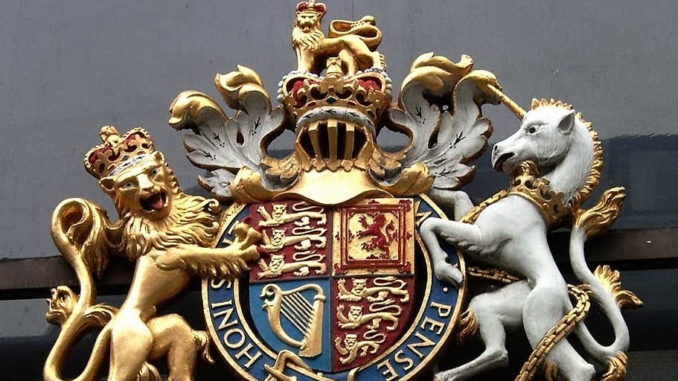
For the last 250 years, the name Rothschild has been synonymous around the world with money, gold, finance, power – both political and industrial. Reactions to the name range from admiration and envy, to fear and disdain, for reasons just as wide and perhaps understandable, as the family is acknowledged as one of the richest ever in history. So admiration for what the family has achieved, but fear for how the fortune has been – and possibly can still be – utilised, with strong evidence indicating that events around the world have often been generated and/or controlled by the Rothschilds for their own benefit.
The current net worth of the family is estimated at anything from a minimum of $300 billion to as much as many trillions – so widely is the family and its wealth now spread, that an accurate estimate is impossible.
[one_half]
[/one_half][one_half_last]
The family is notionally Jewish, most probably Ashkenazi Jews originating from the area between the Black and Caspian Seas and who adopted Judaism in the 8th century – their ancient history is somewhat vague. Regardless, the family’s rise to prominence didn’t begin until the 18th century, in Frankfurt in what is now Germany.
[/one_half_last]
Mayer Amschel Bauer was born in 1743, in Frankfurt, the son of money lender Moses Amschel Bauer who above the door to his business erected a red hexagon – this ‘red shield/sign’ translates into German as ‘rot schild’, and became the name Rothschild which Mayer adopted as his surname in his 20s. (Some sources suggest that the name may have been used by ancestor Izaak more than 100 years previously.) Mayer initially worked in Hanover for an Oppenheimer-owned bank – another name synonymous with wealth – and by devious means became a confidant of Prince William of Hesse-Hanau; he quickly realised that lending money to royalty and governments was far more profitable and secure than to individuals. He was also permitted to have himself recognised publicly as a ‘court factor’, immeasurably improving his stature in the financial and business world.
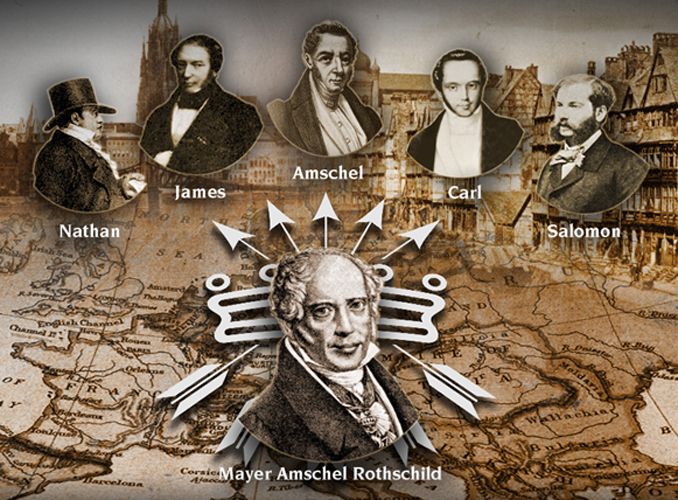
Mayer and his wife Gutle had five sons: the first, Amschel Mayer, was born in 1773(d. 1855), Salomon Mayer the following year(d. 1855), Nathan Mayer in 1777(d. 1836), Kalmann Mayer in 1788(d. 1855), and Jacob Mayer in 1792(d. 1868). Each were to become vital in the growth and spreading influence of the Rothschild business and hence fortune, initially in the European financial world, but later their tentacles were to spread almost worldwide. Mayer also had five daughters, details of their lives are sketchy, but they enabled the Rothschild family to spread their influence, although hidden, by accident or design, under different names. During the 19th century in particular, future generations were to almost always marry first or second cousins, so careful were the family to retain control of their expanding businesses.
[one_half]
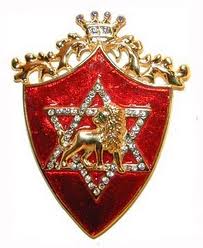
[/one_half][one_half_last]
Mayer became adept at financing the many small states and free cities existing in what is now Germany, but in the 1770s he also had influence on developing “The Illuminati”, under the direction of Adam Wieshaupt, supposedly an organisation with altruistic aims of fighting ‘official” corruption and nepotism, but essentially a self-serving system to undermine political and religious orders, and place them in debt to the Rothschilds.
[/one_half_last]
[one_half]

[/one_half][one_half_last]
Over the next several years, Mayer dispatched his sons to the four other major European financial centres – Nathan established a bank in London, after landing in Manchester in 1798; Jakob (James) in Paris in 1811; Kalmann in Naples in 1821; Salomon in Vienna in 1822; Amschel remained in Frankfurt. These were to be permanent migrations – there was no doubt that the aim was to establish branches of the family business, and to facilitate co-operation between them in the ambition to become possibly the most important family-run business in Europe, and therefore the richest.
[/one_half_last]
The Emperor Francis 11 of Austria granted four baronetcies to the family as early as 1816, Nathan in 1818, so importantly useful an influence was the family even at that point. In 1847 and then in 1885, Queen Victoria elevated two of the Rothschilds to hereditary Baronetcies, a further indication of the family’s importance in British financial and other business circles.
Mayer and his sons are suspected of involvement in several wars, partly to undermine states to the family’s own ultimate advantage, but also because they could back both sides anyway, as the victor in war guaranteed the debts of the vanquished. The financial basis had been an amount of $3 million left with Mayer for safe-keeping by Prince William, in fear of Napoleon, but which was never to be repaid.
[one_half]
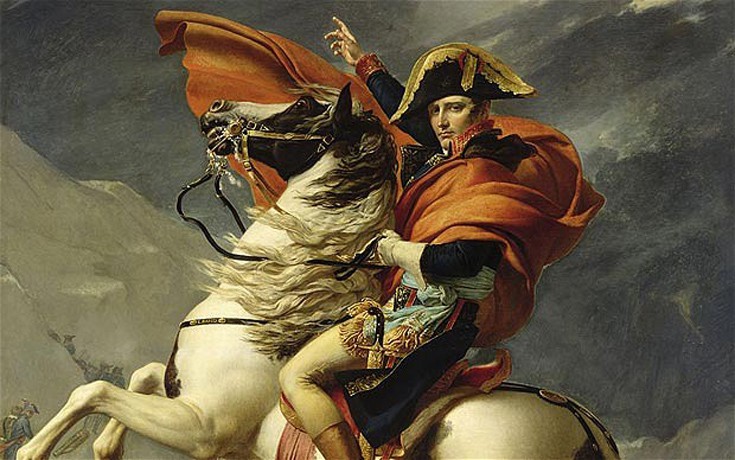
[/one_half][one_half_last]
The French Revolution and then Napoleonic Wars provided the family with enormous opportunities, as their control of gold (bullion) and its transportation enabled easy support of Britain and her allies, but also of the French. Of particular note was Nathan’s early receipt in London of news of the Battle of Waterloo, then behaving as though the British had lost, only to buy bonds back at an enormous discount before the victory was proclaimed.
[/one_half_last]
He is said to have claimed a 20 to one payout, increasing his initial stake of $25,000 to around $60 million at this point in time. In fact, the holdings of Nathan were such that he saved the British government in a cash liquidity crisis in 1825.
[one_half]

[/one_half][one_half_last]
Concurrently, Nathan – who supposedly because of his greater success had been elected head of the family business on his father’s death, contrary to the eldest son assuming control – was involved in the War of 1812, having established The First Bank of the United States through agent Alexander Hamilton, believing that a US defeat would then enable the family to control US finances. This plan didn’t work, or at least, it was the British who needed Rothschild assistance.
[/one_half_last]
Rothschilds were permitted to open the Second Bank of the US, only to have it disestablished by President Jackson in the 1830s, which ended the family’s major influence in the US.
However, in 1825 loans of over $3 million to Brazil financed the new country’s independence from Portugal, which additionally took on repayment of an earlier loan from the Rothschilds to Portugal of around $2 million. Rothschilds influence had spread to South America.
Nathan married Hannah, daughter of Levy Barent Cohen originally from an Amsterdam family involved in finance, and they had seven children, six of whom married within the family including to a Cohen, and one into petty royalty – a British minister of the crown. Significant projects during the 19th century included financing the Suez Canal, and bankrolling Cecil Rhodes to form the future Zimbabwe – Africa was now within Rothschilds’ purvue, which later included De Beers. The banking operations stayed within the English branch of the Rothschilds until 2003, when they merged with the French operation.
In France, following the demise of Napoleon, Jakob subsequently bought-up French bonds, issued with borrowed money, only to sell rapidly and then effectively take-over supply of finance to the government when their finances collapsed. However, the French branch played a significant roll in the re-building of the country during the rest of the century, including extensive industrialisation.
In 1835, the Spanish quicksilver mines at Almaden were leased to the Rothschilds indefinitely, thus giving the family a virtual monopoly of the refining of gold and silver in Europe.
[one_half]

[/one_half][one_half_last]
A notable, if not necessarily financially rewarding purchase initially, was what became Chateau Moutin Rothschild, followed later by Chateau Lafitte, becoming two of the most famous and enduring names in the world of wine production.
In 1904, the Japanese government solicited the unified Rothschild branches in London to fund their efforts in the Russo-Japanese War; the issue of Japanese war bonds totalled around $1.5 billion in 2016 currency terms – east Asia was now beholden to the Rothschilds.
[/one_half_last]
Jakob married his niece, the daughter of Salomon, and they had five children, four of whom married within the family, and one to an influential financier.
In Italy, Kalmann quickly established relationships with both the Austrian-dominated Naples government, and the Vatican, formulating significant loans to the Papal States as well as to various Italian states including Naples, Tuscany and Parma, However the unification of Italy in 1861 dramatically reduced Rothschilds’ influence, and the branch was soon closed.
Kalmann married Adelheid Herz and they had five children, four of whom married within the wider Rothschild family – son Anselm died aged 18. Mayer Carl and Wilhelm Carl subsequently succeeded their childless uncle Amschel in Frankfurt on his death in 1855.
[one_half]
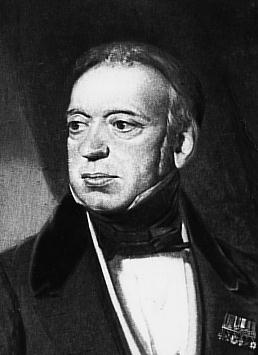
[/one_half][one_half_last]
Salomon became domiciled in Vienna in 1820, and rapidly developed a very significant role in all levels of banking, eventually becoming the largest banking concern in the Empire, which endured effectively until the anschluss of 1938, after which their business was subsumed by the Nazis, and their properties confiscated. Much of their property wasn’t returned until 1999. His operations included supporting construction of the railway network in Austria-Hungary to a large degree.
Salomon married Caroline Stern, and they had a son and a daughter, both of whom married within the family. To his credit, Salomon was a noted philanthropist, in particular donating many pieces of art to a range of galleries and museums around Europe.
[/one_half_last]
Meantime, Amschel Mayer concentrated on business in the middle of Europe until his death in 1855, but again, unification – this time of Germany in 1871 – soon significantly reduced the ability of the Rothschild business to influence state matters, although they had been involved in the Franco-Prussion War which had preceded it. Chancellor Bismarck was nobody’s fool, and apparently regarded the Rothschild’s overtures of financial support with suspicion.
Attempts to set up banking operations in Russia were repulsed by the Tsar, and – again – in the US were unsuccessful, to the extent that President Lincoln had had a new currency printed to circumvent the Rothschild’s influence on the major American banks.
Now well-established in the UK in particular, from where their major projects are co-ordinated, the family has even entered the Chinese banking market as of 2006, and there are allegedly very few countries left in which Rothschilds do not have a presence. Perhaps unsurprisingly given the long-established neutrality of the country both politically and financially, a further important base is in Switzerland.
The Rothschilds have certainly survived well into the modern era, notwithstanding the suspicion with which they are still regarded, amid rumours of their involvement in many major events and conspiracies over the years. Many allegations have been shown to originate from anti-Semitic bias, and as has been pointed out, many supposed Rothschild machinations would be counter-productive, certainly from the middle of the 19th century, as conflict would not benefit the family’s ownership of, for example, government bonds, a significant pillar of their wealth.
[one_half]
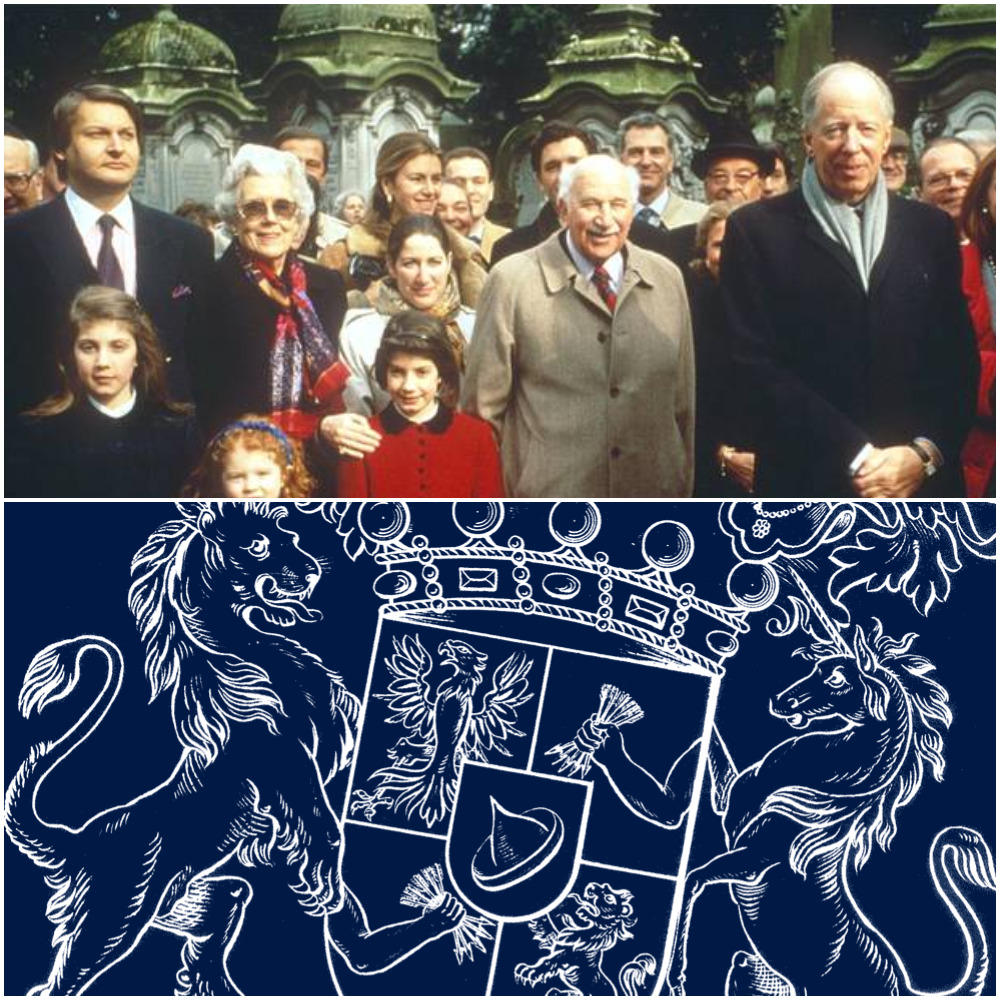
[/one_half][one_half_last]
The family has taken a rather lower public profile in recent years, but then with such an extensive family and range of names, the difficulty is establishing who is related to whom, and which businesses are linked, formally or informally, and that needs very significant further research. Suffice to say that there are well over 50 people very prominent in politics, finance and many industries, still exerting considerable influence around the world, although not necessarily under the Rothschild name. To list just a few, both bloodline and by marriage, shows the family’s continuing influence:
[/one_half_last]
Ariane de Rothschild, (nee Ariane Elizabeth Langner, wife of Benjamin de Rothschild) – President of the Executive Committee of Edmond de Rothschild since 2015, and vice-president of the Edmond de Rothschild Holding SA
Benjamin de Rothschild, a Swiss banker, the chairman of the Edmond de Rothschild Group, a private bank established by his father and owned by the family.
Lord Cholmondeley, a direct descendant of Sir Robert Walpole. First Prime Minister of Great Britain; a direct descendent of both the Rothschild and Sassoon families.
Baron David René James de Rothschild, chairman of Swiss Rothschild Continuation Holdings; ex-chairman of De Beers; Chairman of the Governing Board of the World Jewish Congress.
Emma Georgina Rothschild, CMG, British, but Professor of History at Harvard University; a trustee of the Rothschild Archive.
Sir Evelyn Robert Adrian de Rothschild, Her Majesty’s financial adviser; ex-director of de Rothschilds Freres; directed the merger of Rothschild’s French and UK houses.
Nathaniel Charles Jacob Rothschild, 4th Baron Rothschild, Chairman of J Rothschild Capital Management; Member of the Council for the Duchy of Cornwall for HRH The Prince of Wales.
Save
The post Establishment of The Rothschild Dynasty appeared first on Net Worth Post.
Leave a Reply